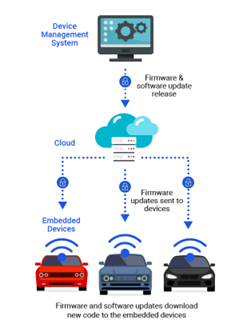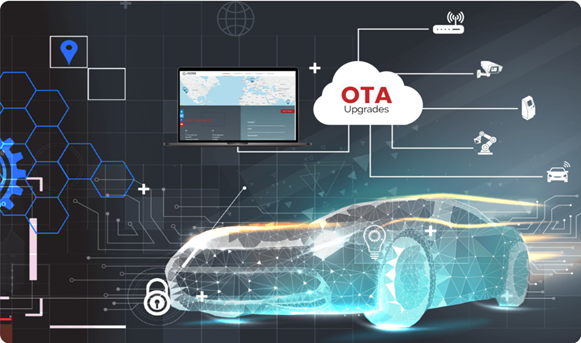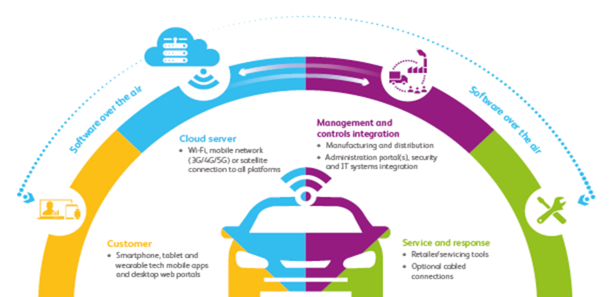Abstract:
This white paper explores the different types of Over-The-Air (OTA) automotive system architectures that are being used in the automotive industry. The increasing complexity of vehicles has led to a greater reliance on software, making OTA updates essential for maintaining and improving vehicle functionality. In this paper, we discuss the benefits and challenges of each OTA architecture type, including Firmware-Over-The-Air (FOTA), Software-Over-The-Air (SOTA), and Full-System-Over-The-Air (FSOTA). We also explore the role of security in OTA updates and the potential impact of OTA updates on the future of the automotive industry.

Introduction:
Automotive vehicles are becoming more complex, with more electronic components and software integrated into the vehicle. This has led to a greater need for Over-The-Air (OTA) updates to maintain and improve vehicle functionality. OTA updates allow manufacturers to remotely update vehicle software, without requiring the owner to take the vehicle to a service center. This has the potential to reduce maintenance costs and increase customer satisfaction. In this white paper, we explore the different types of OTA architectures that are being used in the automotive industry.
Over-the-air (OTA) software updates have become an essential component of modern automotive systems. OTA updates enable automakers to provide software upgrades, bug fixes,
and security patches remotely, without requiring the vehicle owner to visit a dealership. In this white paper, we will discuss several types of OTA system architectures that are commonly used in the industry. With OTA updates, car manufacturers can improve vehicle performance, enhance safety features, and provide a better driving experience to customers without requiring them to visit a service center. However, OTA updates require a reliable and secure system architecture to protect the vehicle and its occupants from potential cyber threats. In this white paper, we will discuss the types of OTA automotive system architectures that car manufacturers can adopt to enable safe and secure software updates. These updates enable manufacturers to improve the functionality and performance of their vehicles without requiring the vehicle owner to bring the car to a dealership for a software upgrade.
Firmware-Over-The-Air (FOTA):
Firmware-Over-The-Air (FOTA) is the most basic type of OTA architecture. It allows manufacturers to remotely update the firmware of electronic components in the vehicle, such as the Engine Control Unit (ECU) or the Transmission Control Unit (TCU). FOTA updates are typically small and can be done quickly. However, FOTA updates are limited to updating firmware only and cannot update software.

Software-Over-The-Air (SOTA):
Software-Over-The-Air (SOTA) is a more advanced type of OTA architecture. It allows manufacturers to remotely update software in the vehicle, such as the infotainment system or driver assistance systems. SOTA updates are typically larger than FOTA updates and can take longer to complete. However, SOTA updates provide more flexibility in terms of what can be updated and can even introduce new features to the vehicle.

Full-System-Over-The-Air (FSOTA):
Full-System-Over-The-Air (FSOTA) is the most advanced type of OTA architecture. It allows manufacturers to remotely update the entire system of the vehicle, including both firmware and software. FSOTA updates are the largest and can take the longest to complete. However, FSOTA updates provide the most comprehensive updates and can even address safety issues in the vehicle.
Types of OTA Automotive System Architectures:
There are four types of OTA automotive system architectures: client-server, peer-to-peer, hybrid, and cloud-based architectures.
1. Client-Server Architecture:
The client-server architecture is the most basic OTA architecture, where the vehicle acts as a client and communicates with a central server for updates. This architecture is simple to implement and can support large data transfers, making it ideal for updating infotainment and multimedia systems. However, it can be slow and inefficient for updating critical safety systems.
2. Peer-to-Peer Architecture:
The peer-to-peer architecture allows vehicles to communicate with each other directly, without the need for a central server. This architecture is ideal for updating critical safety systems in real-time, as it is faster and more efficient than the client-server architecture. However, it may not be suitable for large data transfers, and the reliability of the updates depends on the availability and reliability of other vehicles in the network.
3. Hybrid Architecture:
The hybrid architecture combines client-server and peer-to-peer architecture to create a more flexible system. In this architecture, vehicles communicate directly with each other for critical safety updates, while infotainment and multimedia updates are handled by a central server. This architecture provides the benefits of both the client-server and peer-to-peer architectures but can be complex to implement.
4. Cloud-based Architecture:
The cloud-based architecture involves storing vehicle data and software updates in the cloud, which can be accessed by vehicles through wireless networks. This architecture is highly scalable and can support real-time updates for both safety and infotainment systems. However, it requires a reliable and secure cloud infrastructure and can be vulnerable to cyber-attacks.
5. Embedded OTA Architecture:
The Embedded OTA Architecture is integrated into the vehicle’s Electronic Control Units (ECUs). It is a simple and reliable architecture that ensures fast and secure OTA updates. The embedded architecture is suitable for vehicles with limited connectivity options, such as remote or rural areas. The main advantage of this architecture is that it provides complete control over the update process and ensures that updates are only applied to the intended components. However, its limited connectivity can cause some challenges in cases where the update is large or requires real-time data processing.
Impact on the Automotive Industry:
Over-The-Air (OTA) updates are increasingly becoming an integral part of modern automotive systems. OTA updates enable remote software and firmware updates, configuration changes, and diagnostics, without requiring a physical visit to the dealership. The benefits of OTA updates include improved safety, reliability, and security, reduced maintenance costs, and enhanced customer experience. OTA updates also enable automakers to address recalls and fix software bugs faster, reducing downtime and improving the brand’s reputation. In addition, OTA updates can provide new features and services that enhance the customer experience and increase customer loyalty. OTA updates are expected to become even more critical as connected and autonomous vehicles become more prevalent.
Conclusion and Future work:
In conclusion, the implementation of OTA updates in the automotive industry can lead to significant benefits such as improved safety, increased efficiency, and cost-effectiveness. By reducing the need for physical recalls and maintenance, OTA updates can save time and resources while also providing real-time updates and bug fixes. However, the implementation of OTA systems comes with challenges such as ensuring secure and reliable communication, protecting against cyber-attacks, and addressing compatibility issues. Future research should focus on addressing these challenges and developing more advanced OTA systems that can handle increasingly complex software and hardware configurations. Additionally, there is a need for standardized protocols and regulations for OTA updates in the automotive industry to ensure interoperability and safety.
